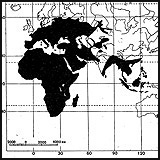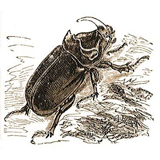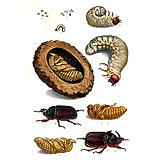The SCARABAEIDAE Family
subfamily DYNASTINAE
The Dynastinae (rhinoceros beetles or Rhino beetle) are among the largest of beetles, so named because of the characteristic horns borne by the males of many species in the group. In fact, the sexes are usually dimorphic (except Phileurini and some Cyclocephalini and some Pentodontini) with males having either horns or enlarged tubercles or enlarged foretarsi. The male beetles use their horns in mating battles against other males. Their larva stage is long, several years in some species. The larvae feed on rotten wood while the adults feed on nectar, plant sap and fruit. In tropical areas rhinoceros beetle larvae are sometimes fried and eaten as a bush delicacy. Dynastinae are also the strongest animals on the planet, proportionally. They can lift up to 850 times their own weight (Wikipedia).
The late Sebo Endrodi (1985) developed a complete revision of the subfamily; from his work most of the information here below are extracted and syntetized. General information are also extracted from Brett C. Ratcliffe who I thank.
The subfamily is divided into eight tribes. In the Palaearctic region about 80 species grouped in 5 tribes and 22 genera are known:
- tribe Phileurini: Eophileurus Arrow, 1908 (10 species and 2 subenera);
- tribe Cyclocephalini: Peltonotus Burmeister, 1874 (1 species);
- tribe Dynastini: Allomyrina Arrow, 1911 (2 species), Chalcosoma Hope, 1837 (3 species),
Eupatorus Burmeister, 1847 (2 species), Xylotrupes Hope, 1837 (1 species);
- tribe Oryctini: Blabephorus Fairmaire, 1898 (1 species), Dichodontus Burmeister, 1847 (1 species),
Hoploryctoderus Prell, 1933 (1 species), Oryctes Illiger, 1798 (12 species in 4 subgenera), Trichogomphus Burmeister, 1847 (4 species);
- tribe Pentodontini: Alissonotum Arrow, 1908 (9 species), Coptognathus Burmeister, 1874 (2 species),
Dipelicus Hope, 1845 (1 species), Eutyctus Semenov, 1889 (1 species), Haplosoma Semenov, 1889 (1 species),
Heteronycus Dejan, 1833 (10 species), Microryctes Arrow, 1908 (1 species), Musurgus Vauloger, 1898 (2 species),
Papuana Arrow, 1911 (1 species), Pentodon Hope, 1837 (9 species with many subspecies), Phyllognathus Eschcholtz, 1830 (2 species),
Podalgus Burmeister, 1847 (1 species with 3 subspecies), Temnorhynchus Hope, 1837 (2 species);
In the Levant only 6 genera (Oryctes, Pentodon, Phyllognathus, Heteronychus, Podalgus and Temnorhynchus)
are recorded and 13 species need to be considered.
Tribe ORYCTINI
Head and pronotum with tubercles or horns (especially males) and pronotum usually with fovea (especially females). Club of antenna small. Mandibles with lateral lobes or teeth. Apex of posterior tibia strongly crenulate or with teeth (including apical tooth). Prosternal process prominent, columnar. Onychium with 3 or more setae at apex.
The Oryctini are distributede is world wide.
Genus Oryctes Illiger, 1798
Big rhinoceros beetles with outer side of mandibles without teeth, frons in male with with a more or less long horn, in female with a tubercle. Thirthy-eitht species of the genus are known, most of them are living in the Ethiopian Region. In the Palaearctic Region the genus Oryctes comprises 14 species in 4 subgenera.
 |
Only 2 species are recorded from Levant:
Oryctes (Oryctes) nasicornis kuntzeni Fabricius, 1787
Oryctes (Rykanoryctes) agamemnon sinaicus Walker, 1871
Tribe PENTODONTINI
Head and pronotum with carina, tubercles, or fovea. Club of antenna usually small. Mandibles usually with 1-3 lateral lobes or teeth. Apex of posterior tibiae generally truncate or finely crenulate, not toothed. Prosternal process long, columnar. Onychium at apex usually with two setae. The Pentodontini is the largest tribe of Dynastinae, and its species occur everywhere except for the polar regions.
Genus Pentodon Hope, 1873
Black and more or less shining species, with clypeous rounded, bidentate or broadly truncated, fron with one or two tubercles, outer side of mandible tridentate. Nine species are known, 7 live in the Palaearctic and two in the Oriental Region. From the 7 Palaearctic species a subspecies reached India, while a population was introduced to Australia (from Endroedi).
Pentodon algerinum dispar Baudi, 1870
Pentodon bidens sulcifrons Kuster, 1848
Pentodon caminarius caminarius Faldermann, 1835
Pentodon idiota idiota Herbst, 1789
Pentodon quadridens distantidens Reitter, 1899
Pentodon variolopunctatus deserti Heyden, 254
Genus Phyllognathus
Brownish red, shininh species. Cypeus strongly contracted toward apex, latter rounded, Frons of males with a horn, that of females with a tubercle. Pronotum of males with a large and deep cavity, that of females almost simply convex. Apex of hind tibiae strongly dilatated with numerous notches and bristles.
From the five species of the genus only two P.excavatus and P.dionysius Fabricius, 1792 occur in Palaearctic Region, P.dionysius also in the Oriental and three in the Ethiopian Region (among them Phyllognathus sabatinellii Endroedi, 1979 from East Africa). P.hauseri Reitter, 1894, considered by Medvedev as a separate species is now considered synonymous of P.excavatus.
Phyllognathus excavatus Forster, 1771
Genus Heteronychus Dejean, 1833
Ten species are know from the Palaearctic Region of which only two in the Levant: H.licas Klug, 1835 and H.parumpunctatus Burmeister, 1847.
Heteronychus licas Klug, 1835
Heteronychus parumpunctatus Burmeister, 1847
Genus Podalgus Burmeister, 1847
Small, red rarely dark brown species with clypeum triangular and apex acuminated, frons with a fine transversal carina, mandible tridentate, anterior tibiae tridentate, hind tibiae strongly dilated toward apex, apical margin truncated with sparse and very fine notches and short bristle, anterior tarsi in males not thickened (from Endroedi).
Only one species is known: P.cuniculus Fairmaire, 1895 largely distributed in Tropical Africa and South Easte part of the Palaearctic Region. Five subspecies are described of which 3 for the Palaearctic Region: P.cuniculus infantulus Semenov, 1889, P.cuniculus reichei Paulian, 1954 and P.cuniculus arabicus Fairmaire, 1895. The latter is the only present in the Levant.
Podalgus cuniculus arabicus Fairmaire, 1895
Genus Temnorhynchus Hope, 1837
Head with a steep bidentate place (see images below), basal border of plate also marked with two teeth. Anterior part of pronotum of males extensively impressed, behind with small tuberble, that of female only declivous without a tubercle. Anterior tibiae tridentate, anterior tarsi in males not thickened (from Endroedi).
From the 25 species of the genus only two, T.baal Reiche and Saulcy, 1856 and T.coronatus Fabricius, 1871 occur in the Palaearctic Region the others in the Ethiopian Region.
Temnorhynchus baal Reiche and Saulcy, 1856
References
Endrodi, S. 1985 - The Dynastinae of the World. Dr. W. Junk Publisher, Dordrecht. 800 pp., 46 plates.

